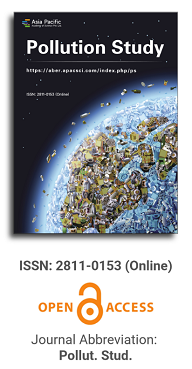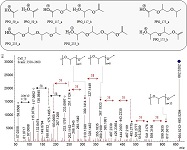
Asia Pacific Academy of Science Pte. Ltd. (APACSCI) specializes in international journal publishing. APACSCI adopts the open access publishing model and provides an important communication bridge for academic groups whose interest fields include engineering, technology, medicine, computer, mathematics, agriculture and forestry, and environment.

The (partial) replacement of synthetic polymers with bioplastics is due to increased production of conventional packaging plastics causing for severe environmental pollution with plastics waste. The bioplastics, however, represent complex mixtures of known and unknown (bio)polymers, fillers, plasticizers, stabilizers, flame retardant, pigments, antioxidants, hydrophobic polymers such as poly(lactic acid), polyethylene, polyesters, glycol, or poly(butylene succinate), and little is known of their chemical safety for both the environment and the human health. Polymerization reactions of bioplastics can produce no intentionally added chemicals to the bulk material, which could be toxic, as well. When polymers are used to food packing, then the latter chemicals could also migrate from the polymer to food. This fact compromises the safety for consumers, as well. The scarce data on chemical safety of bioplastics makes a gap in knowledge of their toxicity to humans and environment. Thus, development of exact analytical protocols for determining chemicals of bioplastics in environmental and food samples as well as packing polymers can only provide warrant for reliable conclusive evidence of their safety for both the human health and the environment. The task is compulsory according to legislation Directives valid to environmental protection, food control, and assessment of the risk to human health. The quantitative and structural determination of analytes is primary research task of analysis of polymers. The methods of mass spectrometry are fruitfully used for these purposes. Methodological development of exact analytical mass spectrometric tools for reliable structural analysis of bioplastics only guarantees their safety, efficacy, and quality to both humans and environment. This study, first, highlights innovative stochastic dynamics equations processing exactly mass spectrometric measurands and, thus, producing exact analyte quantification and 3D molecular and electronic structural analyses. There are determined synthetic polymers such as poly(ethylenglycol), poly(propylene glycol), and polyisoprene as well as biopolymers in bags for foodstuffs made from renewable cellulose and starch, and containing, in total within the 20,416–17,495 chemicals per sample of the composite biopolymers. Advantages of complementary employment in mass spectrometric methods and Fourier transform infrared spectroscopy is highlighted. The study utilizes ultra-high resolution electrospray ionization mass spectrometric and Fourier transform infrared spectroscopic data on biodegradable plastics bags for foodstuffs; high accuracy quantum chemical static methods, molecular dynamics; and chemometrics. There is achieved method performance |r| = 0.99981 determining poly(propylene glycol) in bag for foodstuff containing 20,416 species and using stochastic dynamics mass spectrometric formulas. The results highlight their great capability and applicability to the analytical science as well as relevance to both the fundamental research and to the industry.
Environmental injustice in journalism: Analysis of pesticide pollution reporting
Vol 4, Issue 2, 2023
Download PDF
Abstract
The objective of this paper is to discuss the approach of journalism to the use of pesticides as a situation that generates environmental injustice. To make such a reflection, we rely on the series of Zero Hora reports published in December 2016 on the contamination of Ceasa products, in Porto Alegre, by pesticides banned in Rio Grande do Sul (Brazil) or used above the limit set by law. We start from Acselrad’s conception of environmental justice. This is a notion that refers to socio-political dynamics since it includes conflicts arising from the violation of the rights of human communities due to unsustainable use of the environment. To assess the impact of injustices in the media, we resorted to the assumptions of Environmental Journalism, a perspective that defends the mobilizing function of journalism based on a complex view of the phenomena (Girardi et al.) from a descriptive and qualitative analysis (Martins). Among the results, it is noted that the series does not incorporate a systemic view of the problem, ignoring the impacts of pesticides on the entire production chain and ecosystems.
Keywords
References
- INCA. Position of the José Alencar Gomes da Silva National Cancer Institute on agrotoxics (Portuguese). Available online: http://www1.inca.gov.br/inca/Arquivos/comunicacao/posicionamento_do_inca_sobre_os_agrotoxicos_06_abr_15.pdf (accessed on 2 June 2023).
- Acselrad H. Environmentalization of social struggles - the case of the environmental justice movement (Portuguese). Estudos Avançados. 2010; 24(68): 103-119. doi: 10.1590/s0103-40142010000100010
- Girardi IMT. Paths and byways of Environmental Journalism (Portuguese). C&S. 2012; 34(1): 131-152.
- Martins J. Qualitative research (Portuguese). In: Fazenda I. (editor). Metodologia da pesquisa educacional. São Paulo: Cortez; 2001. pp. 47-58.
- Gil AC. Social research methods and techniques (Portuguese). São Paulo: Atlas; 2008.
- Carneiro, F. Food and nutrition security and health (Portuguese). In: Carneiro F, Augusto L, Rigotto R, et al. (editors). Dossiê ABRASCO: um alerta sobre os impactos dos agrotóxicos na saúde. Rio de Janeiro: EPSJV; 2015.
- Lutzenberger JA. Ecological foundations of organic farming (Portuguese). In: Curso de Agricultura Biológica. Porto Alegre: SARGS/Assembleia Legislativa do Rio Grande do Sul; 1981. pp. 52-71.
- Girardi IMT. Agricultural journals and the ideology of agricultural modernization (Portuguese) [Master’s thesis]. Instituto Metodista de Ensino Superior; 1988.
- Brum A. Modernization of agriculture: wheat and soya (Portuguese). Ijuí: Fidene/Unijuí; 1985.
- Pinheiro S. Back to the future (Portuguese). In: Pinheiro, S. (editor). Agropecuária sem veneno. Porto Alegre: L± 1985. pp. 99-144.
- Facchini LA, Souza LE, Apresentação. ABRASCO dossier: a warning about the health impacts of pesticides (Portuguese). São Paulo: Expressão Popular. 2015; 37-40.
- CNA. Kátia Abreu charges agility in the release of agricultural defensives. Available online: http://senadorakatiaabreu.com.br/katia-abreu-cobra-agilidade-na-liberacao-de-defensivos-agricolas (accessed on 2 June 2023).
- Romano RT. (2016) Os agrotóxicos e os produtos fitossanitários. Available online: https://jus.com.br/artigos/50472 (accessed on 2 June 2023).
- Petersen P. ABRASCO dossier: a warning about the health impacts of pesticides (Portuguese). São Paulo: Expressão Popular. 2015; 27-36.
- History of Organic Agriculture: some considerations. Available online: http://planetaorganico.com.br/ site/index.php/historia-da-agricultura-organica-algumas-consideracoes/ (accessed on 2 June 2023).
- Portal B. Agricultura orgânica deve movimentar R$ 2,5 bi em 2016. Available online: http://www.brasil.gov. br/economia-e-emprego/2015/10/agricultura-organica- deve-movimentar-r-2-5-bi-em-2016 (accessed on 2 June 2023).
- Herculano S. The cry for environmental justice and against environmental racism (Portuguese). InterfacEHS. 2008; 3(1): 1-20.
- Girardi IMT, Loose EB, Camana A. Overview of Environmental Journalism research in Brazil: the state of the art in dissertations and theses between 1987 and 2010 (Portuguese). Porto Alegre, UFRGS; 2015.
- Bueno W. Communication, journalism and the environment: theory and research (Portuguese). São Paulo: Majoara; 2007.
- Bueno WDC. Environmental journalism: exploring beyond the concept (Portuguese). Desenvolvimento e Meio Ambiente. 2007; 15. doi: 10.5380/dma.v15i0.11897
- Bacchetta V. Planetary citizenship (Portuguese). Montevideo: International Federation of Environmental Journalists; 2000.
- Gil AC. How to design a documentary survey (Portuguese)? In: Gil AC. (editor). Como elaborar projetos de pesquisa. São Paulo, Atlas; 2002. pp. 87-92.
- Grupo de Investigação RBS. Danger on the plate: invisible evil (Portuguese). Jornal Zero Hora. 2016; 6-13.
- Grupo de Investigação RBS. Danger on the plate: smuggling into RS (Portuguese). Jornal Zero Hora. 2016; 24-27.
- Grupo de Investigação RBS. Danger on the plate: your health at risk (Portuguese). Jornal Zero Hora. 2016; 10-16.
- Gelós HS. Environmental Journalism: communicational axis of the XXI century. Jornalismo Ambiental: desafios e reflexões. 2008; 67-74.
- Grupo de Investigação RBS. Danger on the plate: Pernambuco—agreement reduces food contamination (Portuguese). Jornal Zero Hora. 2016; 24-25.
- Grupo de Investigação RBS. Danger on the plate: MP and police to investigate pesticide abuse (Portuguese). Jornal Zero Hora. 2016; 32-33.
- Girardi IMT, Schwaab RT. Challenges and reflections (Portuguese). Jornalismo Ambiental. 2008.
- Primavesi O. Food production collides with the environment because it suffers from greed (Portuguese). Formação & Informação Ambiental: jornalismo para iniciados e leigos. 2004; 177-201.
- Loose EB, Girardi IMT. Environmental journalism from the perspective of climate risks. Ínterin Magazine (Portuguese). 2017; 22(2): 154-172.
- Frome M. Green Ink: an introduction to Environmental Journalism (Portuguese). Curitiba: Editora UFPR; 2008.
- Garcia R. About the earth: a guide for those who read and write about the environment (Portuguese). Lisbon: Público; 2006.
Supporting Agencies
Copyright (c) 2023 Por Ilza Maria Tourinho Girardi, Débora Gallas Steigleder, Jamille Almeida da Silva, Eloisa Beling Loose
License URL: https://creativecommons.org/licenses/by/4.0

This site is licensed under a Creative Commons Attribution 4.0 International License (CC BY 4.0).
.jpg)
Beijing University of Technology, China



